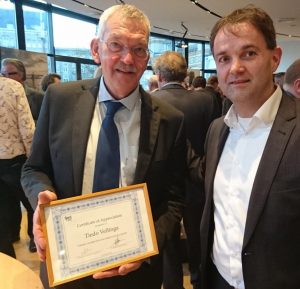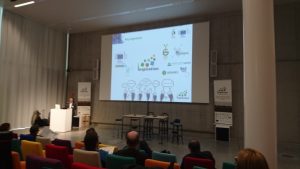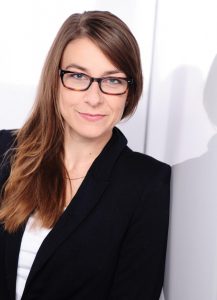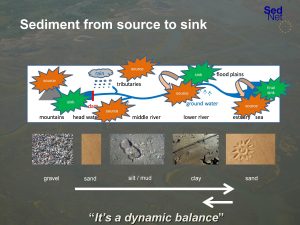Website: www.SedNet.org
Compiled by: Marjan Euser (marjan.euser@deltares.nl)
Subscription Service: SedNet Secretariat (marjan.euser@deltares.nl)
Disclaimer: SedNet is not responsible for faults due to incorrectness of info in this newsletter
Previous issues: www.sednet.org/newsletter
Contents:
- ELSA and SedNet – a perfect fit
- Thank you Tiedo!
- European Strategic Research Agenda for soil (and a little bit sediment)
- SedNet working group quantity
- Sediments and Circular Economy
- SURICATES – Sediment Uses as Resources In Circular And Territorial EconomieS
- Sediment management in deltas – Implications and challenges of disturbed sediment continua for society
- A quantitative assessment of human interventions and climate change on the West African sediment budget
- Upcoming events
ELSA and SedNet – a perfect fit
Today, the options for the Port of Hamburg to handle sediments for navigation are heavily affected by upstream contamination of Elbe sediments.
Axel Netzband, chairman of SedNet in the period 2006-2012, and former employee of the Hamburg Port Authority was among those experts who realized in the 1990s, that an improvement of the sediment quality in Hamburg is only possible through a holistic sediment management in the whole Elbe catchment area, and that such management should comprise in particular measures reducing sediment contamination and the mobilization of contaminated sediments in the upstream river catchment area. And because the first Elbe management plan, prepared under the WFD (2010-2015), highlighted contamination as one of the most important supra-regional issues in water resources management and underlined that contaminated sediments are among the main reasons for the failure to meet the WFD management objectives and pose substantial risk to the marine environment, in Hamburg the idea came up to found a project supporting remediation of contaminated sediments in the whole Elbe catchment area. The ELSA-project was born.
In close cooperation between the Hamburg Ministry of Environment and Energy, the Hamburg Port Authority and the Hamburg Ministry of Economy the ELSA-project was equipped with financial support from the City of Hamburg up to an amount of 11 Mio. Euro. At the same time, the International Commission for the Protection of the Elbe River (ICPER) started a working group on sediment management under the supervision of Peter Heininger (Federal Institute of Hydrology, Germany), one of the founding members of SedNet. The resulting sediment management concept of the ICPER now includes recommendations for an economic and ecological handling of sediments and dredged material. The concept is deeply inspired by SedNet’s ideas and combines the issues of sediment quantity, hydromorphology and sediment quality as well as ecological and use-oriented sediment aspects in one concept. The ELSA-project closely worked together with the international sediment working group and both conceptually and financially supported the work on recommendations for a good sediment management practice in the Elbe.
ELSA is continuing this support in the 2nd WFD management cycle. It was generally acknowledged that the work of ELSA is of a long-term nature and thus should be implemented in the permanent organisational structure at the Hamburg Ministry of Environment and Energy. Since the beginning of 2018 the ELSA-project is integrated into the department “Tidal Elbe and Marine Protection”, now allowing a completely integrated perspective “from the mountains to the sea”!
Contact: Ilka Carls, ilka.carls@bue.hamburg.de
Free and Hanseatic City of Hamburg, Ministry of Environment and Energy, ELSA-Project
In January 2018 ELSA joined the SedNet Steering Group.
SedNet-SG is very pleased to welcome Ilka Carls as representative of ELSA!
Thank you Tiedo!
Tiedo Vellinga, from the Port of Rotterdam Authority was one of the key-persons involved in the initiation of SedNet. He was the chairman of the SedNet Steering Group during the first three years (January 2002 – December 2004) when SedNet was set-up with financial support of the European Commission under its 5th RTD Framework Program. It is also very much thanks to Tiedo’s leadership and wisdom that SedNet could sustain from January 2005 onwards as fully self-supporting network and matured into the very much alive-and-kicking network as it is today. Tiedo retired 1st of December 2017. At that occasion our current SedNet chairman Marc Eisma, also from the Port of Rotterdam Authority, awarded Tiedo with a SedNet certificate (see photo) expressing our appreciation for his contribution and dedication to SedNet. Once more: thank you Tiedo for your enthusiasm and support to SedNet!European Strategic Research Agenda for soil (and a little bit sediment)
European Strategic Research Agenda for soil (and a little bit sediment)
 The European Commission’s co-funded Horizon 2020 Coordination and Support Action INSPIRATION (www.inspiration-h2020.eu) had its final conference in Brussels, 4-6 December 2017. At this event, INSPIRATION’s main product, i.e. the European strategic research agenda (SRA) for “Integrated Spatial Planning, Land Use and Soil Management” was made public. The SRA was developed through a bottom-up process that engaged more than 500 experts (science, management, policy making, industry, NGOs) from 20 European countries. The SRA is accessible on-line at: www.inspiration-agenda.eu. Although the key-focus is on soil and land-use/management, the SRA also covers some sediment management related research needs. SedNet contributed to the final conference with the session “S.O.S – Save Our Sediments”. There is an INSPIRATION briefing note available on this topic, see: http://www.inspiration-h2020.eu/page/research-agenda. The S.O.S. session resulted in additional suggestions for sediment related SRA topics. These suggestions are also passed to, and further elaborated in the SedNet working group on “Sediment Quantity Management of entire River-Sea Systems” (see next E-news item).
The European Commission’s co-funded Horizon 2020 Coordination and Support Action INSPIRATION (www.inspiration-h2020.eu) had its final conference in Brussels, 4-6 December 2017. At this event, INSPIRATION’s main product, i.e. the European strategic research agenda (SRA) for “Integrated Spatial Planning, Land Use and Soil Management” was made public. The SRA was developed through a bottom-up process that engaged more than 500 experts (science, management, policy making, industry, NGOs) from 20 European countries. The SRA is accessible on-line at: www.inspiration-agenda.eu. Although the key-focus is on soil and land-use/management, the SRA also covers some sediment management related research needs. SedNet contributed to the final conference with the session “S.O.S – Save Our Sediments”. There is an INSPIRATION briefing note available on this topic, see: http://www.inspiration-h2020.eu/page/research-agenda. The S.O.S. session resulted in additional suggestions for sediment related SRA topics. These suggestions are also passed to, and further elaborated in the SedNet working group on “Sediment Quantity Management of entire River-Sea Systems” (see next E-news item).
SedNet working group Quantity
The SedNet working group (WG) on “Sediment Quantity Management of entire River-Sea Systems” was initiated at our last SedNet conference, 14-17 June 2017 in Genoa. The initial WG objectives (open for further adaptation) are in brief:
- To increase the general awareness for sediment quantity management;
- To promote the sharing of experiences and best management practice in this field;
- To develop a related strategic research and innovation agenda (SRIA), not only focusing on research, but also on sound solutions (measures), their effectiveness and feasibility;
- To promote the developed SRIA to potential funders.
WG membership is free of charge and open to any professional willing to engage and (pro-)actively contribute to achieving the WG objectives. Today’s members of the WG come from Europe and beyond and bring in the perspectives from a.o. science, policy making, management, navigation, NGO as well as industry. The next WG workshop is held 7 and 8 March 2018 at the Deltares main office in Delft. In this workshop we aim to refine the WG starting document as well as to jointly produce the first drafts for some other possible WG products, such as a flyer/brochure for the WG, a (scientific) review paper and the first version of the SRIA. If you are interested to engage in this WG, then please contact: Jos Brils: jos.brils@deltares.nl.
Sediments and Circular Economy
Dredged sediments are often disposed of at sea or on land, and considered as waste, according to national regulations. There is not yet anything like a common status for dredged sediments across Europe. As such, they are one of the bulkiest waste flows in Europe. They can also be seen as a resource – a large supply of minerals, easily accessible by water transport in many active regions of the world. This qualifies sediments as first priority target for circular economy and reuse in order to reduce waste and to preserve natural resources and materials.
Despite the long established tradition of management by disposal, several EU-funded projects (Prisma, GeDSeT, Setarms, CEAMaS, …) and other regional initiatives (for instance, the “Sédimatériaux” approach, funded by the “Hauts-de-France” region) investigated reuse scenarios (such as road base, concrete, landscaping, etc.) and attempted to fill technology gaps. They succeeded in identifying viable reuse opportunities, and thus to demonstrate the technical and environmental feasibility through concrete and operational achievements. A second generation of projects (Valse, USAR, Suricates, …) builds on this outcome and moves from laboratory to industrial scale pilots to demonstrate further that reuse is a sustainable alternative to disposal and minerals extraction.
This growing interest was showcased in a lively Sediments and Circular Economy session at the SedNet 2017 Conference in Genoa. This session will be continued at the next SedNet conference, which is planned for 2019.
In order to contribute further to the EU Strategy on Circular Economy, SedNet expressed its interest in the recently started Stakeholders Platform on Circular Economy and will take part in its activities.
A SedNet Working Group on Circular Economy will begin in 2018 too. Its activities will be centered on fostering initiatives on sediment reuse, and on offering an exchange forum to sediment practitioners, policymakers and scientists involved in reuse promotion. If you wish to be involved, or to know more about the Working Group activities, please drop a line at the SedNet secretary (marjan.euser@deltares.nl).
SURICATES – Sediment Uses as Resources In Circular And Territorial EconomieS
Last year the SURICATES project started, co-funded by INTERREG North-West Europe. The aim of the project is to increase sediment reuse for erosion and flood protection. The project will provide authorities, port and waterway managers and erosion experts with new large scale solutions for sediment reuse in NWE ports, waterways and coastlines.
Climate change, erosion and flood risk increase require greater mitigation measures, consuming high volumes of natural resources. However, dredged sediments are a problem for EU ports/waterways providing navigation access with 200 million m3/y (80 million tonnes dry weight) generated. Increased social and environmental pressures show the critical need for new solutions to maintain and develop activity. Currently, more than 99% of EU marine sediment dredged is dumped at sea/managed as waste, with only 1% (800 000 t/year) reused. In SURICATES, 220 000t of sediment will be used in 4 new solutions as raw material to build resilient flood/erosion protection systems. We target an increase in the number of sediment reuse projects in NWE to drive sediment reuse to 1.3 Mt/y after 5 years, and 2.3Mt/y after 10 years in the EU. From the CEAMaS project national/global potential interest in reuse strategies demonstration, we will provide support for erosion/flood risk market development with local impact optimisation of sediment reuse. We will implement tools and methods for global impact quantification at regional scale using social, economic, employment and environmental modelling and we will test eco-innovative techniques in real-life conditions providing long term impact evaluation and guidelines for replication: riverbank strengthening, regeneration of harbour/river banks and beach nourishment.
Pilot implementation with long term impacts on territories is planned within the project for UK and NL. Networking activities for dissemination and operational guidance illustrated by 3 new projects for Fr, UK and IE will be developed and shared with local, national and EU authorities for implementation on project completion.
Total project budget is € 5.67 m and duration of the project is 2017-2021.
Project Partner organisations are: Cork Institute of Technology, Deltares, University of Strathclyde, Port of Rotterdam, Université de Lille Sciences et Technologies, University College Cork – National University of Ireland, IXSANE, Bureau de Recherches Géologiques et Minières, British Waterways T/A Scottish Canals, Association pour la Recherche et le Développement des Méthodes et Processus Industriels.
Sediment management in deltas – Implications and challenges of disturbed sediment continua for society
River to the coastal sea sediment continua are disturbed, globally. Several river-sea-systems are short of sediment mostly due to damming. This causes dramatic impacts such as drowning deltas. Scientists and stakeholders should team-up urgently in research and innovation to find solutions. On 9 March a symposium will be held in Vlaardingen (near Rotterdam), addressing the status in the Rhine/Meuse – North Sea system. Furthermore, the DANUBIUS-RI research infrastructure (RI) is presented as disturbed sediment continua may become a key research topic in this RI. The symposium also aims to gain support and ingredients for drafting of a sediment continuum call text to promote as topic under EC FP9, i.e. the follow-up of Horizon 2020.
More info and registration via https://ncr-web.org/events/5/seminar-sediment-in-deltas/#registration
A quantitative assessment of human interventions and climate change on the West African sediment budget
Last year, during the Sednet conference in Genoa, a World Bank study was presented, focussing on the setting up of an integrated large-scale sediment budget study for West Africa. The presentation is available at https://sednet.org/2017-pres9-1-miguel-toquica-and-alessio-giardino/
In the meantime a paper describing the methodology and main outcomes from this study has been published in the Journal Ocean & Coastal Management and it is freely available through the following link: http://www.sciencedirect.com/science/article/pii/S096456911730203X
In the article is shown how major man-made interventions at the coast or at the river catchments can disrupt the sediment transport in the region. Consequences may even be felt beyond political boundaries. Although man-made interventions are the major source of erosion in the region in the current situation, climate change and sea level rise may overrule this by the end of century. The study is carried out by means of a consistent integrated modelling system including the coastal system and all major river catchments.
Upcoming events
7-8 March: Workshop SedNet Working Group Sediment Quantity, at Deltares in Delft. See article in this newsletter. For information: jos.brils@deltares.nl
9 March: Symposium “Sediment management in deltas – Implications and challenges of disturbed sediment continua for society”, Vlaardingen, the Netherlands. The event is organized by the Netherlands Centre for River Studies (NCR), Netherlands centre for Coastal Research (NCK), DANUBIUS-RI, Deltares, and Utrecht University Future Deltas.
More info and registration on https://ncr-web.org/events/5/seminar-sediment-in-deltas/#registration
8-13 April: EGU General Assembly 2018, Vienna, Austria. The yearly European Geosciences Union assembly has a broad programme, covering sediments, sustainable management of deltas, climate change, etc. For details see the website: www.egu2018.eu
7-11 May: 34th PIANC World Congress in Panama. PIANC, the World Association for Waterborne Transport Infrastructure, and The Panama Canal Authority (ACP) will co-host the 34th PIANC World Congress 2018 in Panama City. The Congress will present and discuss the most relevant topics to the waterborne transport infrastructure sector. The event is open also to non-members. Short courses on 6 May. Website: www.pianc2018.com
13-17 May: 28th SETAC Europe Annual Meeting in Rome. See for instance the sediments session: “Holistic Risk Assessment of Chemicals in Sediments and Soils Using Weight of Evidence Approaches” (chairs: Sebastian Höss, Ute Feiler, Susanne Heise, Lucie Bielská) under track 4. Ecological risk assessment and human health risk assessment of chemicals, mixtures and stressors and risk mitigation strategies.
Abstracts for posters can be submitted until 2nd May!
Website: https://rome.setac.org/programme/scientific-programme/
4-8 June: 3rd edition of the I.S.Rivers international conference on integrative sciences and sustainable development of rivers, Lyon, France. See the conference website.
19-21 June: 7th International Symposium “Monitoring of Mediterranean coastal Areas: problems and measurement techniques”, Livorno, Italy. Organised by the Institute of Biometeorology of the Italian National Research Council of Italy, in collaboration with other Research Institutes and University Departments. Sessions on Morphology and evolution of coastlines and seabeds, Coastal landscapes: past and present aspects of human influence, Measures for environment and energy production in the coastal zones, Coastline geography: territorial dynamics and integrated protection, Flora and Fauna of the littoral system: dynamics and protection.
See the conference website.
Disseminated by:
SedNet secretariat:
Mrs. Marjan Euser
Deltares
P.O. Box 85467
NL-3508 AL Utrecht
The Netherlands
Email marjan.euser@deltares.nl



